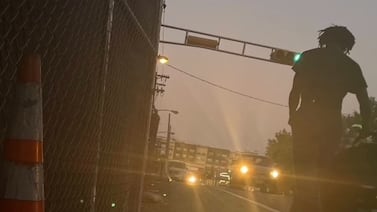The decision to apply for a waiver to Tennessee’s remote learning ban was not taken lightly.
Fayette County Schools Superintendent Versie Hamlett had been monitoring student and staff absenteeism at LaGrange-Moscow Elementary, one of the rural West Tennessee district’s seven schools. Day after day, the numbers kept rising until, on Jan. 13, they reached a breaking point: 18% of students, 16% of teachers, and 25% of other school staff members were absent.
“There comes a time when you really don’t have enough staff to run the facility appropriately and safely,” Hamlett said. “We thought through [the waiver] process and we thought it was the best thing to do, for our students especially, to stay home until this kind of passes over.”
As school districts and charter school networks across Tennessee and around the country face unprecedented staffing obstacles during the latest COVID wave, families, child care providers, and school officials are struggling to keep up with school closures and remote learning reminiscent of the early days of the pandemic.
The obstacles are especially acute in Tennessee, where state law prevents school leaders from closing buildings and switching to remote learning without approval from the state’s top education official, Commissioner Penny Schwinn — and even then, only for five days at a time.
After the delta variant surge late last summer, waiver requests subsided in the fall. But they again exploded with the new year after the omicron variant arrived.
As of Jan. 20, the Department of Education had received 107 waiver requests since the process began Aug. 27, said spokesman Brian Blackley. Of those, 100 were approved, including one partial approval, and two were denied. Five additional requests were deemed ineligible.
The process in Tennessee can translate to desperation and disruption – and a limited ability to plan ahead – for students and families who have endured a challenging past two years.
For Jamie Jones, a child care provider in Oakland, a rural town of nearly 7,000 in Fayette County, last week felt like 2020 all over again. She juggled looking after four children in her care, while also tutoring first grader Olivia and walking her through worksheets sent home from LaGrange-Moscow Elementary.
Olivia — who attended Jones’ birth-to-prekindergarten day care for the first several years of her life — had returned to Jones’ care for the week. When her school abruptly announced on Thursday it would be closed a week starting the following day due to COVID spread and staffing concerns, her mom had nowhere else to send her — until she reached out to Jones.
Jones’ in-home day care has what she proudly calls a “revolving door” — she’ll take an extra child into her care here and there to help out, but she estimates that she’s one of two providers in all of Fayette County. She can’t help but wonder where other parents, at LaGrange-Moscow Elementary or elsewhere, send their children when in need of child care with short notice.
“We really don’t have places for our kids to go. It’s friends, families, or people like me,” Jones said. “There was no panic on my end — I love my job and I’m flexible. But I know there was a lot of panic among the parents.”
Going remote is not simple for Tennessee schools
Across the nation, shortages, frustration, and resilience have marked the return from winter break for school systems in places such as Detroit, Chicago, and Newark, N.J., where districts temporarily closed school buildings for a week or more.
But that hasn’t been the case in Tennessee, which is one of at least 10 other states that explicitly require in-person learning to be offered, according to a recent Education Commission of the States report.
If local school administrators conclude in-person instruction is no longer feasible, they must get Schwinn’s approval for a waiver for an individual class or school.
Here’s how the process works: School officials submit an application, answering questions about the number of schools or classrooms in need of remote learning, the counts and percentage of students, teachers, and school staff who are absent because they’re quarantining or in isolation, and why they’re no longer able to provide in-person instruction.
The state’s waivers to go remote are for five calendar days, rolled back from the seven-day waivers approved last semester. The shortened window is due to federal and state guidance that cut in half the recommended isolation time for people testing positive for the coronavirus from 10 days to five.
Schwinn did not respond when asked through a spokesman how well the waiver process is working for students and parents.
State Sen. Page Walley, whose West Tennessee district includes Fayette County, said that the system has been helpful in giving school leaders an option to pursue.
“I believe these waivers are being thoughtfully sought,” said the Bolivar Republican. “They’re time-limited and serving their purpose, which is to get people through when a rapid wave [of COVID] is affecting the population in one school.”
Walley also said he likes that Schwinn is making the call about switching to remote learning, instead of leaving it up to superintendents or charter school leaders.
“It gives us another set of eyes to look at the data, which then reinforces the decision-making process. That’s also helpful for local leaders if they’re ever questioned about a decision,” Walley said, adding that he hasn’t received any complaints about the remote waiver process.
‘There are not enough bodies’
The voices from administrators strike a different tone — one that often conveys a sense of desperation.
Memphis’ Soulsville Charter School, which serves over 600 students in grades 6-12, had “exhausted all of our resources to keep school in person,’’ executive director NeShante Brown wrote in the school’s waiver application on Jan. 7. With almost a quarter of teachers and just over 15% of other school staff in isolation or quarantine, plus others out due to other illnesses, “there are not enough bodies” to keep Soulsville open, Brown said.
The situation was similar at Beacon College Preparatory, another Memphis charter school, where officials reported 10% of teachers and 36% of students were absent Jan. 17.
“It is not feasible to conduct in-person learning without ⅓ of our student population and a lead teacher,” Joe Buldoc, founder and head of the Memphis charter school, wrote in his application.
“It’s a crisis when you can’t staff schools,” said Dale Lynch, executive director of Tennessee’s superintendents organization. “School leaders are having a very difficult time keeping their schools operational under omicron, whether it’s having enough teachers or bus drivers, cafeteria workers, or teacher aides.”
They’d rather keep school buildings open, Lynch added, but are glad that waivers give them an option to temporarily move students to remote learning.
Many of the most recent requests have come from rural and suburban districts in Middle Tennessee, though several smaller urban districts, such as Knoxville, and charter schools in Memphis, such as Soulsville and Beacon College Preparatory, have also asked to move to remote instruction. Meanwhile, Shelby County Schools, the state’s largest school district, has not applied for a waiver. District officials say they’ve been able to make staffing work so far.
In some cases, getting a waiver at one school has helped district officials patch staffing holes in other schools.
While LaGrange-Moscow was closed, Hamlett said healthy staff members were sent to other schools in the district that were struggling to keep their doors open, and students were sent home with learning packets.
Although the situation is far from ideal, Hamlett said she’s grateful for Schwinn’s support during the waiver process and for the school community’s continued patience.
“We’re in a pandemic and we have to do what’s best for our students and everyone has been really understanding of that,” she said.
Short notice on closures can stir panic
Cynthia Kennon, whose daughter is in fourth grade at LaGrange-Moscow Elementary, said she understands the school’s situation. The school’s sudden closure was not stressful for Kennon — she is unable to work because she has rheumatoid arthritis, and her daughter was able to stay home with her — but she knows that less than 24-hour notice of a school closure sends many working parents into panic mode.
Sending a letter home with students at the end of one school day informing them the school would be closed the next isn’t enough notice, she said.
“I mean, there was really no actual warning,” Kennon said, though she knew COVID cases were climbing at the school.
While Kennon had time to work with her daughter on the printed learning packets sent home with her, she also knows not every parent has that luxury. On top of it all, Kennon’s daughter has dyslexia and reading through the packet likely took her longer than other children.
Her daughter’s special education teacher also recommended they complete the work following her school schedule in order to keep the same routine of a school day — something a working parent would not be able to do.
Those kinds of challenges that parents face during school closures are part of the reason why Gary Lilly, superintendent of Collierville Schools, applied for a virtual learning waiver at the high school level rather than the elementary or middle schools.
All of the district’s schools had reached a breaking point, Lilly said. After exhausting the district’s substitute teacher pool, school leaders resorted to covering classrooms with teacher assistants, school principals, and even administrators from the central office.
On Monday, Jan. 11, Lilly realized the district wouldn’t be able to make the rest of the week work. But, Lilly wondered, which school does it make sense to move to remote learning?
Cases were soaring at the high school: As of Jan. 10, 14% of students and teachers and 29% of school support staff were either infected with COVID or had potentially been exposed to the virus. Plus, Lilly figured Collierville High is by far the district’s largest school, and going remote would have the greatest impact on limiting spread of the virus.
In addition, students at that age are more independent and are better equipped to learn online compared to elementary and middle school students, Lilly said.
“Parents, understandably, don’t want to leave their small children home alone and nor should they,” Lilly said. “It really made sense to do it at the high school level.”
Lilly applied for the waiver around lunch time that day; Schwinn approved the request around 3 p.m. By 4 p.m., the district had notified parents of the shift to remote instruction. He knew most high school students would be able to stay home alone and could manage attending class virtually.
While Lilly was initially nervous about the waiver process, in the end, it wasn’t difficult. Still, having to get state approval is yet another hurdle in an already turbulent school year, Lilly said.
“This year has been more challenging even than previous years,” Lilly said. “We thought we were coming out of the pandemic, and just when you’re about to get some relief, you hear about a new variant and it all kind of starts over again.”
“We’re doing what we can; we’re making it work,” he added. “But it’s challenging.”









